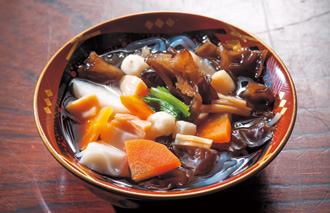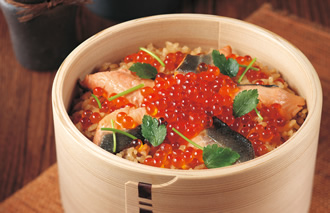niponica is a web magazine that introduces modern Japan to people all over the world.
2018 NO.23
 Strolling Japan
Strolling Japan
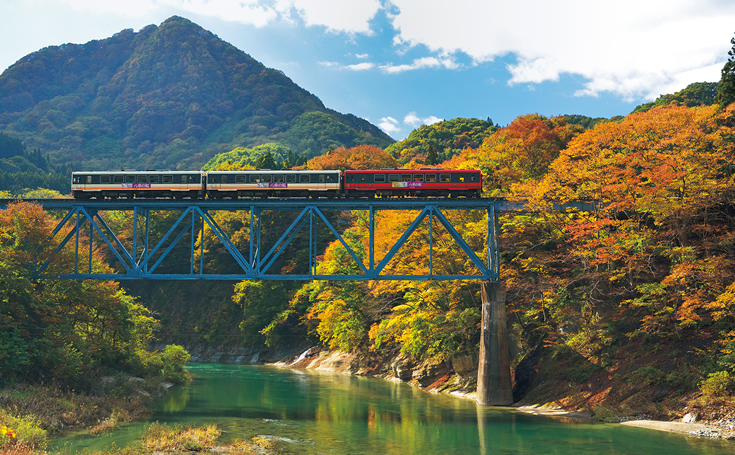
Aizu Railway connects Nishiwakamatsu Station in Aizuwakamatsu City and Minami Aizu Kogen Ozeguchi Station in Minami-Aizu-cho.
Mt. Seaburi, located between Aizuwakamatsu and Lake Inawashiro, is known for its gorgeous sunrises and sunsets. From the mountaintop, majestic views unfold—Lake Inawashiro gleaming far below in the morning sun, or the sun setting in exquisite hues behind another mountain in the distance.
Higashiyama Onsen, a popular hot spring area dating as far back as the 8th century, is about a 10-minute ride from the city by car. Long extolled by eminent persons and literati, dozens of hot spring inns and hotels along the Yugawa River offer visitors the opportunity to soak in the ambience of a traditional old hot spring town.
In Aizuwakamatsu, people still love the traditional local dishes that originated centuries ago—the wonderful flavors of kozuyu soup topped with plenty of vegetables, and wappameshi, a steamed rice dish packed with local vegetables and soup stock. Area farmers have also recently begun reintroducing the traditional vegetables that were commonly grown here as far back as the Edo period.
Aizuwakamatsu offers beautiful mountains, luxurious hot springs, lush nature, as well as food and crafts born of the samurai culture. The colorfully majestic scenes that unfold here are truly unforgettable.
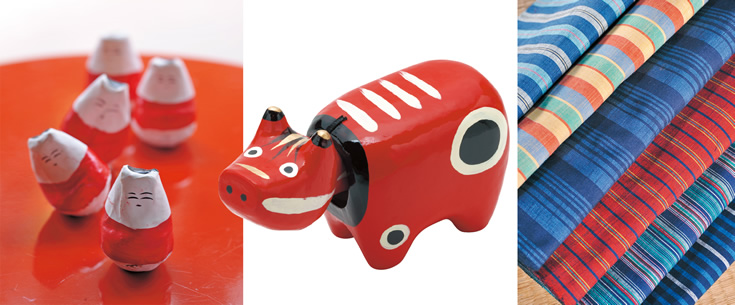
Left: The round-bottomed okiagari-koboshi doll may wobble, but it won’t fall over.
Center: Akabeko bobble head doll. The name is derived from "aka," which means red, and "beko," which means cow in the local dialect.
Right: Known for its famous striped pattern, Aizu cotton is extremely durable.
Kozuyu soup packed with vegetables such as taro root and carrots is often served at celebratory occasions.

Left: Yukishita cabbage, which is actually grown under the snow, is a local specialty known for its fruity sweetness. (Photo courtesy of Fukushima Shinhatsubai)
Center: Aizu kogiku kabocha (pumpkin-like squash) and Aizu maru nasu (round eggplant)—two traditional vegetables grown in Aizuwakamatsu.
Right: Held each year in September, the Aizu Autumn Festival features groups dressed as samurai in period costume. (Photo courtesy of Aizuwakamatsu City government)
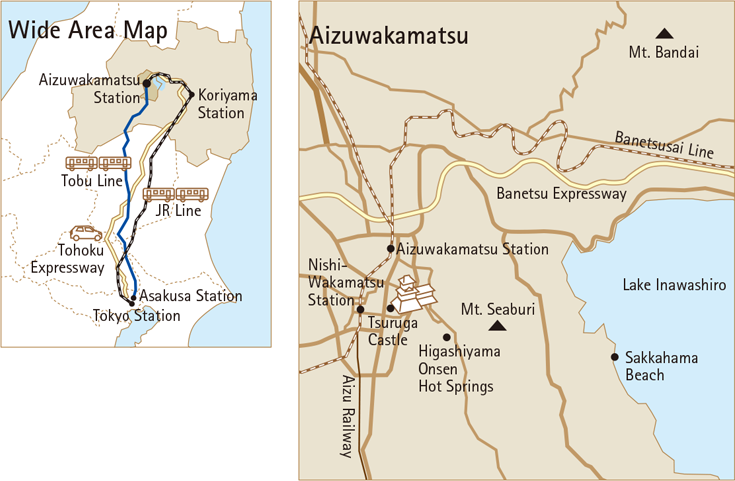
Map of Aizuwakamatsu Area
●Access
By train: Take the JR Tohoku Shinkansen from Tokyo Station to Koriyama Station. Transfer to the Ban-Etsu-West Line and continue to Aizu-Wakamatsu Station. The trip takes approx. 2 1/2 hours. Alternatively, take the Tobu-Yagan Railway to Aizu Kogen Ozeguchi Station and transfer to the Aizu Railway train bound for Aizu-Wakamatsu Station. The trip takes approx. 4 1/2 hours.
By car: Take the Tohoku Expressway from Tokyo (Kawaguchi JCT) and change to Aizuwakamatsu I.C. at the Koriyama JCT. The trip takes approx. 3 hours.
●Information
Aizuwakamatsu Tourist Bureau
http://www.tsurugajo.com/
Higashiyama Onsen Tourism Association
http://www.aizu-higashiyama.com/
Aizu Railway Co., Ltd.
http://aizutetsudo.jp








